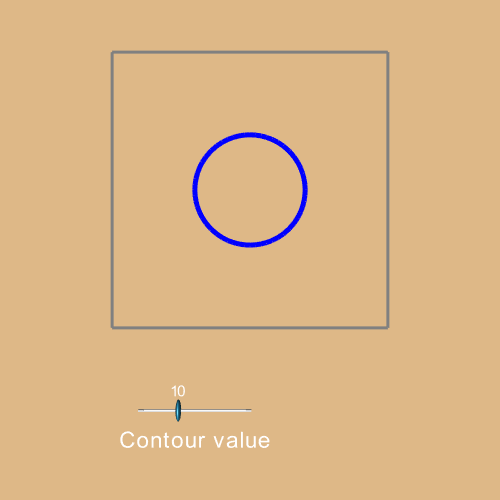IsoContours
vtk-examples/Cxx/ImplicitFunctions/IsoContours
Other languages
See (CSharp)
Question
If you have a question about this example, please use the VTK Discourse Forum
Code¶
IsoContours.cxx
#include <vtkActor.h>
#include <vtkCommand.h>
#include <vtkContourFilter.h>
#include <vtkImageData.h>
#include <vtkInteractorStyleUser.h>
#include <vtkNamedColors.h>
#include <vtkNew.h>
#include <vtkOutlineFilter.h>
#include <vtkPolyDataMapper.h>
#include <vtkProperty.h>
#include <vtkRenderWindow.h>
#include <vtkRenderWindowInteractor.h>
#include <vtkRenderer.h>
#include <vtkSliderRepresentation.h>
#include <vtkSliderRepresentation3D.h>
#include <vtkSliderWidget.h>
#include <vtkXMLImageDataWriter.h>
namespace {
void CreateData(vtkImageData* data);
class vtkSliderCallback : public vtkCommand
{
public:
static vtkSliderCallback* New()
{
return new vtkSliderCallback;
}
virtual void Execute(vtkObject* caller, unsigned long, void*)
{
vtkSliderWidget* sliderWidget = reinterpret_cast<vtkSliderWidget*>(caller);
double value =
static_cast<vtkSliderRepresentation*>(sliderWidget->GetRepresentation())
->GetValue();
this->ContourFilter->GenerateValues(1, value, value);
}
vtkSliderCallback() : ContourFilter(NULL)
{
}
vtkContourFilter* ContourFilter;
};
} // namespace
int main(int, char*[])
{
vtkNew<vtkNamedColors> colors;
vtkNew<vtkImageData> data;
CreateData(data);
// Create an isosurface.
vtkNew<vtkContourFilter> contourFilter;
contourFilter->SetInputData(data);
contourFilter->GenerateValues(1, 10,
10); // (numContours, rangeStart, rangeEnd)
// Map the contours to graphical primitives.
vtkNew<vtkPolyDataMapper> contourMapper;
contourMapper->SetInputConnection(contourFilter->GetOutputPort());
// Create an actor for the contours.
vtkNew<vtkActor> contourActor;
contourActor->SetMapper(contourMapper);
contourActor->GetProperty()->SetLineWidth(5);
// Create the outline.
vtkNew<vtkOutlineFilter> outlineFilter;
outlineFilter->SetInputData(data);
vtkNew<vtkPolyDataMapper> outlineMapper;
outlineMapper->SetInputConnection(outlineFilter->GetOutputPort());
vtkNew<vtkActor> outlineActor;
outlineActor->SetMapper(outlineMapper);
outlineActor->GetProperty()->SetColor(colors->GetColor3d("Gray").GetData());
outlineActor->GetProperty()->SetLineWidth(3);
// Visualize
vtkNew<vtkRenderer> renderer;
vtkNew<vtkRenderWindow> renderWindow;
renderWindow->AddRenderer(renderer);
renderWindow->SetWindowName("IsoContours");
vtkNew<vtkRenderWindowInteractor> interactor;
interactor->SetRenderWindow(renderWindow);
renderer->AddActor(contourActor);
renderer->AddActor(outlineActor);
renderer->SetBackground(colors->GetColor3d("Burlywood").GetData());
vtkNew<vtkSliderRepresentation3D> sliderRep;
sliderRep->SetMinimumValue(0.0);
sliderRep->SetMaximumValue(30.0);
sliderRep->SetValue(10.0);
sliderRep->SetTitleText("Contour value");
sliderRep->SetPoint1InWorldCoordinates(-20, -40, 0);
sliderRep->SetPoint2InWorldCoordinates(0, -40, 0);
sliderRep->SetSliderWidth(.2);
sliderRep->SetLabelHeight(.1);
vtkNew<vtkSliderWidget> sliderWidget;
sliderWidget->SetInteractor(interactor);
sliderWidget->SetRepresentation(sliderRep);
sliderWidget->SetAnimationModeToAnimate();
sliderWidget->EnabledOn();
vtkNew<vtkSliderCallback> callback;
callback->ContourFilter = contourFilter;
sliderWidget->AddObserver(vtkCommand::InteractionEvent, callback);
vtkNew<vtkInteractorStyleUser> style;
interactor->SetInteractorStyle(style);
renderWindow->SetSize(500, 500);
renderWindow->Render();
renderWindow->Render();
interactor->Start();
return EXIT_SUCCESS;
}
namespace {
void CreateData(vtkImageData* data)
{
data->SetExtent(-25, 25, -25, 25, 0, 0);
data->AllocateScalars(VTK_DOUBLE, 1);
int* extent = data->GetExtent();
for (int y = extent[2]; y <= extent[3]; y++)
{
for (int x = extent[0]; x <= extent[1]; x++)
{
double* pixel = static_cast<double*>(data->GetScalarPointer(x, y, 0));
pixel[0] = sqrt(pow(x, 2.0) + pow(y, 2.0));
}
}
vtkNew<vtkXMLImageDataWriter> writer;
writer->SetFileName("data.vti");
writer->SetInputData(data);
writer->Write();
}
} // namespace
CMakeLists.txt¶
cmake_minimum_required(VERSION 3.12 FATAL_ERROR)
project(IsoContours)
find_package(VTK COMPONENTS
CommonColor
CommonCore
CommonDataModel
FiltersCore
FiltersModeling
IOXML
InteractionStyle
InteractionWidgets
RenderingContextOpenGL2
RenderingCore
RenderingFreeType
RenderingGL2PSOpenGL2
RenderingOpenGL2
)
if (NOT VTK_FOUND)
message(FATAL_ERROR "IsoContours: Unable to find the VTK build folder.")
endif()
# Prevent a "command line is too long" failure in Windows.
set(CMAKE_NINJA_FORCE_RESPONSE_FILE "ON" CACHE BOOL "Force Ninja to use response files.")
add_executable(IsoContours MACOSX_BUNDLE IsoContours.cxx )
target_link_libraries(IsoContours PRIVATE ${VTK_LIBRARIES}
)
# vtk_module_autoinit is needed
vtk_module_autoinit(
TARGETS IsoContours
MODULES ${VTK_LIBRARIES}
)
Download and Build IsoContours¶
Click here to download IsoContours and its CMakeLists.txt file. Once the tarball IsoContours.tar has been downloaded and extracted,
cd IsoContours/build
If VTK is installed:
cmake ..
If VTK is not installed but compiled on your system, you will need to specify the path to your VTK build:
cmake -DVTK_DIR:PATH=/home/me/vtk_build ..
Build the project:
make
and run it:
./IsoContours
WINDOWS USERS
Be sure to add the VTK bin directory to your path. This will resolve the VTK dll's at run time.
